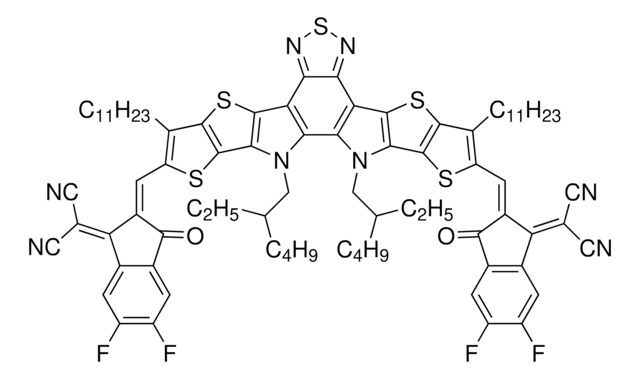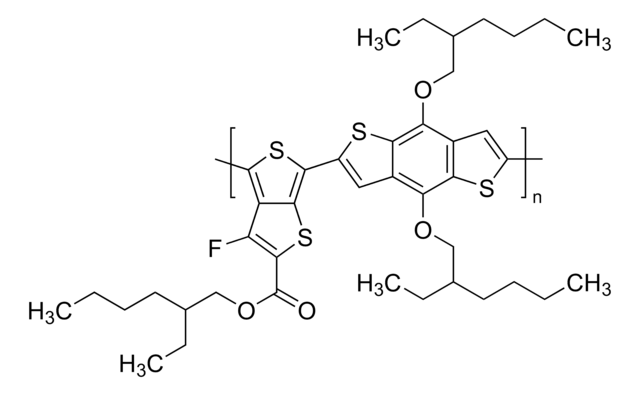Products may be shipped at a different temperature than the recommended long-term storage temperature. If the product quality is sensitive to short-term exposure to conditions other than the recommended long-term storage, it will be shipped on wet or dry-ice. If the product quality is NOT affected by short-term exposure to conditions other than the recommended long-term storage, it will be shipped at ambient temperature. As shipping routes are configured for minimum transit times, shipping at ambient temperature helps control shipping costs for our customers. For more information, please refer to the Storage and Transport Conditions document: https://www.sigmaaldrich.com/deepweb/assets/sigmaaldrich/marketing/global/documents/316/622/storage-transport-conditions-mk.pdf
Kluczowe dokumenty
906336
PBDB-T-2F
Synonim(y):
PCE135, PM6, Poly[[4,8-bis[5-(2-ethylhexyl)-4-fluoro-2-thienyl]benzo[1,2-b:4,5-b′]dithiophene-2,6-diyl]-2,5-thiophenediyl[5,7-bis(2-ethylhexyl)-4,8-dioxo-4H,8H-benzo[1,2-c:4,5-c′]dithiophene-1,3-diyl]-2,5-thiophenediyl]
Wybierz wielkość
2970,00 zł
Wybierz wielkość
About This Item
2970,00 zł
Polecane produkty
opis
Band gap: 1.9 eV
Formularz
particles
masa cząsteczkowa
Mw 80,000-200,000 g/mol by GPC
kolor
Fine
rozpuszczalność
chlorobenzene: soluble
chloroform: soluble
dichlorobenzene: soluble
Energia orbitalna
HOMO -5.5 eV
LUMO -3.6 eV
PDI
2‑4
Powiązane kategorie
Zastosowanie
Polymeric donor material
LUMO=−3.6 eV
HOMO=−5.5 eV
OPV Device Performance:
PBDB-T-2F: ITIC-F (1:1 w/w)
Voc= 0.84V
Jsc= 22.2 mA/cm2
FF= 0.725
PCE=13.5%
PBDB-T-2F (or PM6) is a wide bandgap polymer donor (n-type semiconductor) containing fluorinated thienyl benzodithiophene (BDT-2F) used in high performance polymer solar cells (PSCs). PBDB-T-2F possesses high crystallinity and strong π-π stacking alignment, which are favourable to charge carrier transport and hence suppress recombination in devices. PBDBT-2F based PSCs were reported to have thickness and area insensitive performance and is a promising candidate for large-scale roll-to-roll manufacturing of high-efficiency polymer solar cells.[1][2][3][4][5]
For example, recently, new study have shown PBDB-T-2F:IT-4F(Sigma Aldrich Cat. No. 901423) based PSCs yielded an impressive PCE of 13.5% due to the synergistic effect of fluorination on both donor and acceptor, which is among the highest values recorded in the literatures for PSCs to date [1]. The PBDB-T-2F:IT-4F baed PSCs also showed good storage, thermal and illumination stabilities with respect to the efficiency. High efficiency of >11% was maintained for a wide range of film area and thickness. When paired with selenopheno[3,2-b]thiophene-based narrow-bandgap non-fullerene acceptor, an impressive efficiency of 13.3 % was obtained with thickness-insensitive feature.[4]
It has also been previously reported, PBDB-T-2F when paired with narrow band-gap small molecule acceptor 2,2′-((2Z,2′Z)-((4,4,9,9-tetrahexyl-4,9-dihydro-s-indaceno[1,2-b:5,6-b′]dithiophene-2,7-diyl)bis(methanylylidene))bis(3-oxo-2,3-dihydro-1H-indene-2,1-diylidene))dimalononitrile (IDIC), the as-cast film (without extra treatments) showed an outstanding power conversion efficiency (PCE) of 11.9%[1], a record value for as-cast polymer solar cells. Moreover, the performance of PBDB-T-2F:IDIC based devices is insensitive to the active layer thickness (≅95-255 nm) and device area (0.20-0.81 cm2), and thus is a promising candidate for future roll-to-roll mass manufacturing and practical application of highly efficient PSCs.
It has also been reported, PBDB-T-2F possesses a strong absorption in the short wavelength region of 300-685 nm with a large bandgap of 1.80 eV, which is complementary to that of ITIC (1.55 eV) and facilitates achieving high short-circuit current (Jsc) in PSCs. Moreover, PBDB-T-2F shows a deep HOMO level of −5.50 eV, a strong crystallinity and a dominant face on packing, which helps to achieve a high open-circuit voltage (Voc) and fill factor (FF) in PSCs.[3]
Kod klasy składowania
11 - Combustible Solids
Klasa zagrożenia wodnego (WGK)
WGK 3
Temperatura zapłonu (°F)
Not applicable
Temperatura zapłonu (°C)
Not applicable
Wybierz jedną z najnowszych wersji:
Masz już ten produkt?
Dokumenty związane z niedawno zakupionymi produktami zostały zamieszczone w Bibliotece dokumentów.
Klienci oglądali również te produkty
Produkty
To achieve net-zero emissions by 2050, renewable power contributions must triple. Photovoltaic stations provide vital utility power, achieved primarily through third- and fourth-generation technology. Promising trends include recycling and revolutionary, ultra-lightweight, flexible, and printable solar cells.
Professor Chen (Nankai University, China) and his team explain the strategies behind their recent record-breaking organic solar cells, reaching a power conversion efficiency of 17.3%.
-
How is shipping temperature determined? And how is it related to the product storage temperature?
1 answer-
Helpful?
-
-
How can I determine the shelf life / expiration / retest date of this product?
1 answer-
If this product has an expiration or retest date, it will be shown on the Certificate of Analysis (COA, CofA). If there is no retest or expiration date listed on the product's COA, we do not have suitable stability data to determine a shelf life. For these products, the only date on the COA will be the release date; a retest, expiration, or use-by-date will not be displayed.
For all products, we recommend handling per defined conditions as printed in our product literature and website product descriptions. We recommend that products should be routinely inspected by customers to ensure they perform as expected.
For products without retest or expiration dates, our standard warranty of 1 year from the date of shipment is applicable.
For more information, please refer to the Product Dating Information document: https://www.sigmaaldrich.com/deepweb/assets/sigmaaldrich/marketing/global/documents/449/386/product-dating-information-mk.pdfHelpful?
-
Active Filters
Nasz zespół naukowców ma doświadczenie we wszystkich obszarach badań, w tym w naukach przyrodniczych, materiałoznawstwie, syntezie chemicznej, chromatografii, analityce i wielu innych dziedzinach.
Skontaktuj się z zespołem ds. pomocy technicznej


![[6,6]-Phenyl C71 butyric acid methyl ester, mixture of isomers 99%](/deepweb/assets/sigmaaldrich/product/structures/716/624/9fb9f2f0-ae99-429f-8d3a-b12267976a4d/640/9fb9f2f0-ae99-429f-8d3a-b12267976a4d.png)






![[6,6]-Phenyl C61 butyric acid methyl ester >99.5%](/deepweb/assets/sigmaaldrich/product/structures/359/221/d990c746-0960-4c69-bf76-fe09b193824d/640/d990c746-0960-4c69-bf76-fe09b193824d.png)